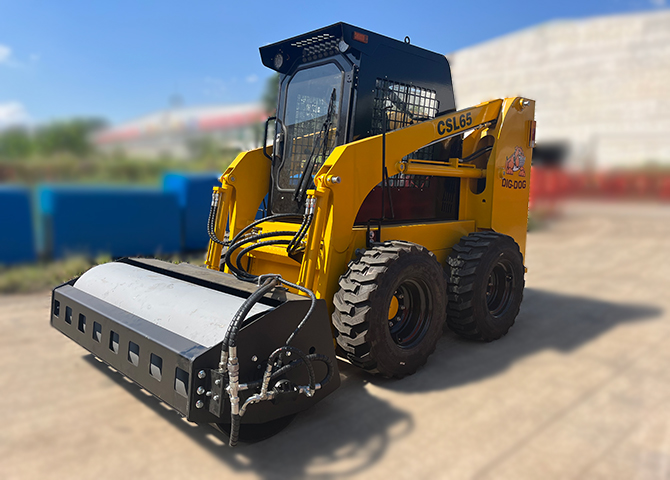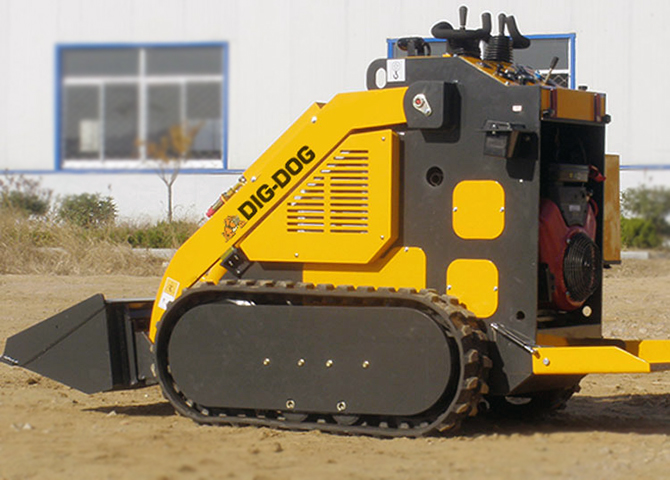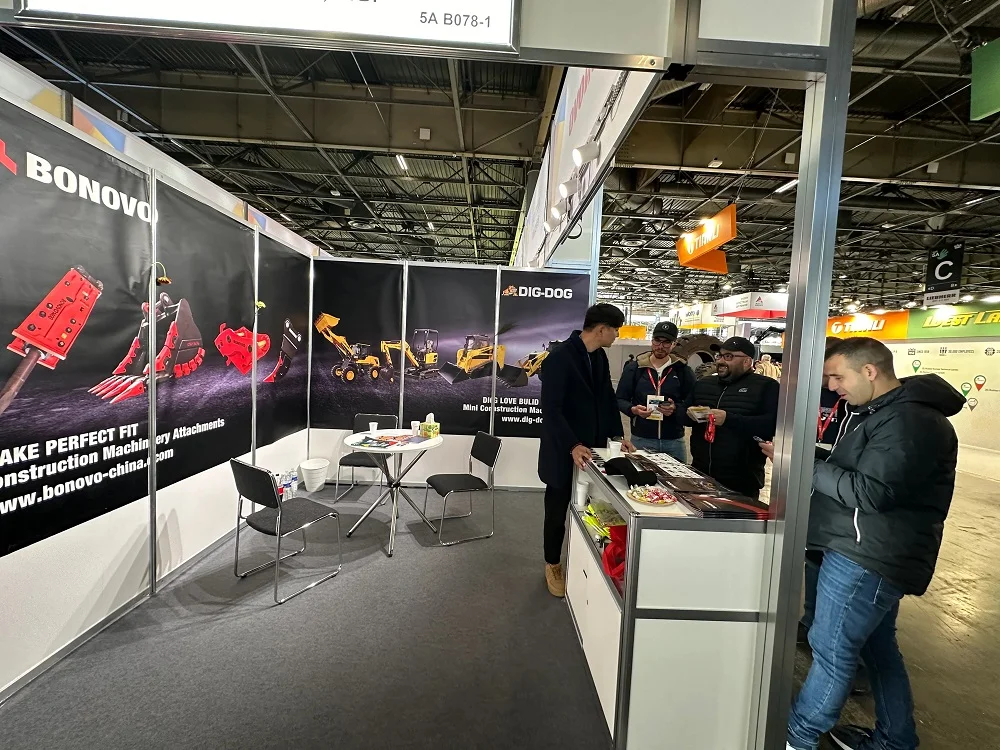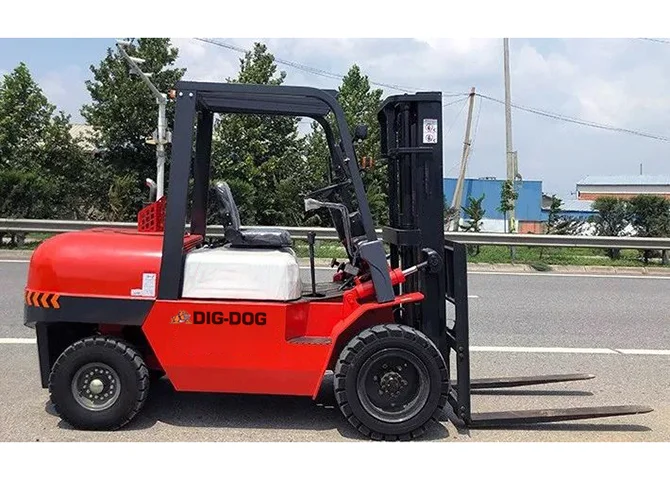 DIG-DOG Skid Steer Loader with Vibratory roller
DIG-DOG Skid Steer Loader with Vibratory rollerIn the bustling realm of construction and landscaping, where maneuverability and versatility reign supreme, the
skid steer loader emerges as a stalwart companion. Whether tasked with moving heavy materials, clearing obstacles, or tackling intricate projects in tight spaces, this compact yet mighty machine proves its worth time and again. Let's embark on a journey to uncover the multifaceted capabilities, unique features, and undeniable benefits of skid steer loaders.
where traditional excavators can't fit?
What about hoisting bulky pallets onto trucks? Have you ever found yourself needing to eliminate an obstructive stump? These seemingly disparate tasks—and more—can all be accomplished with the assistance of a reliable skid steer loader, also known as a compact track loader or posi-track.
But what exactly is a skid steer loader?
Essentially, it's a compact yet versatile piece of equipment primarily utilized for grading and material movement in the Dirt World. However, equipped with a vast array of available attachments, it can tackle a diverse range of tasks. To delve deeper into this robust little machine, let's explore its functionality, popular attachments, and the basics of operating a skid steer loader.
What will a skid steer do?
Skid steer loaders are the Swiss army knives of the dirt world, renowned for their versatility and ability to tackle diverse tasks. Whether digging in narrow spots unreachable by larger excavators or handling small jobs too intricate for bigger machines, they excel in grading, excavation, landscaping, and material handling. Compact yet powerful, they navigate tight spaces, move soil, gravel, sand, and more, clearing debris, snow, and vegetation. Indispensable for earth-moving projects, skid steer loaders are invaluable assets on any job site.
Why is it called a skid loader?
The term "skid steer" derives from the unique steering mechanism employed by these loaders. Unlike conventional vehicles with steering wheels, skid steer loaders utilize a skid-steering system. This system involves the wheels on each side of the machine rotating at different speeds or in opposite directions to turn the loader. As a result, the machine may skid or slide during turns, hence the name "skid steer." This distinctive steering method provides skid steer loaders with exceptional maneuverability, allowing operators to navigate through narrow passages and execute precise movements with ease. While the term "skid loader" is often used interchangeably with "skid steer loader," both refer to the same type of equipment with this specialized steering mechanism.
What are the benefits of skid steer loader?
Skid steer loaders offer numerous advantages that contribute to their widespread popularity and utility across various industries. One key benefit is their compact size, which allows them to operate in confined spaces and navigate through tight areas with ease. This agility enhances productivity on job sites where space is limited, making skid steer loaders indispensable for indoor construction projects, landscaping tasks, and agricultural operations.
Additionally, skid steer loaders are highly versatile machines capable of accommodating a wide range of attachments. With the ability to quickly swap attachments such as buckets, forks, augers, and brush cutters, skid steer loaders can adapt to different tasks and perform multiple functions without the need for multiple pieces of equipment. This versatility not only increases efficiency but also reduces equipment costs and storage requirements for operators.
Furthermore, skid steer loaders are known for their exceptional maneuverability and stability, thanks to their low center of gravity and skid-steering mechanism. This enables operators to perform precise movements and maintain control over the machine, even on uneven terrain or in challenging conditions. Whether it's grading, excavation, snow removal, or material handling, skid steer loaders offer unmatched versatility, efficiency, and reliability, making them essential tools for a wide range of applications.
The true allure of a skid steer loader lies in its versatility. With the appropriate attachment and a skilled operator, a skid steer loader or posi-track can undertake tasks such as:
- Snow removal
- Clearing brush and rocks
- Tree cutting and removal
- Trench backfilling
- Material transport
- Supporting other machinery
- Stump grinding and removal
- Landscape preparation
- Moving pallets and bales
This broad spectrum of capabilities makes a skid steer loader an indispensable asset on any Dirt World job site and a valuable piece of equipment for farm operations like that of our friend Andro, who has a penchant for heavy machinery.
The array of skid steer loader attachments is extensive and could fill volumes. While it wouldn't be surprising if someone devised a skid steer loader attachment for baking bread, some commonly seen attachments on job sites include:
- Augers
- Backhoes
- Breakers/Hammers
- Brooms
- Buckets
- Cement mixers
- Pallet and bale forks
- Mowers
- Harley Rakes
- Saws
- Grapple buckets
- Tillers
- Wood chippers
- Mulchers
- Trenchers
What are the different types of skid steer loaders?
Unlike excavators, skid steer loaders don't have multiple types as much as they have multiple sizes, with one critical differentiation:
Skid steer loaders come in two varieties: wheeled and tracked. Wheeled versions are less common but more economical. They move faster on smooth surfaces like asphalt, facilitating quick deployment between job sites.
Tracked versions offer a distinct advantage, particularly in muddy or uneven terrain, as their tracks provide stability and minimize slipping or tipping. However, tracks can cause damage to surfaces like concrete or asphalt, especially on larger, heavier machines.
For tasks requiring an even smaller footprint than traditional skid steer loaders, there are stand-on/walk-behind models. These compact powerhouses, capable of fitting through standard doorways, offer similar functionality to their full-size counterparts, making them ideal for tight spaces. Demolition and landscape contractors often favor these lightweight and compact machines.
Additionally, there's a plethora of attachments available for these models, although they're not compatible with larger counterparts due to differing connection plates.

Small skid steer loaders
Slightly larger than stand-on models are mini skid steer loaders, also known as small skid steer loaders. These diminutive machines can navigate doorways like their smaller counterparts but boast greater travel speed and carrying capacity. While not as popular, they're favored by pool contractors, landscapers, and some demolition companies for their versatility and maneuverability.
Medium-frame machines
One of the most common sizes, medium-frame skid steer loaders and compact track loaders, come in various types, models, and weights within this category. Despite variations, many share the same engine and frame. These machines are ubiquitous and favored by contractors for their adaptability, handling tasks ranging from loading trucks to trenching with ease.
Large-frame machines
The heavyweight champions, large-frame skid steer loaders and track loaders, boast operating weights comparable to small dozers, up to 16,000 lbs. These formidable machines are preferred by forestry, paving, and grading contractors for their ability to handle heavy loads and high-flow hydraulic attachments. However, their substantial size limits maneuverability and restricts access to confined spaces.
Skid steer loader FAQ
How do you operate a skid steer loader?
Operating a skid steer loader requires skill and practice. Unlike most vehicles, skid steer loaders utilize differential steering, with the left and right pairs of wheels turning at varying speeds. Control is managed via hydraulic joysticks, with the left stick dictating machine direction and the right controlling the loader or attachment. Additionally, the throttle pedal regulates both engine speed and loader arm speed, necessitating full throttle operation during use.
How much does a skid steer loader weigh?
Skid steer loader weight varies by type and brand, typically ranging from 300 to 1,500 kg for smaller models. Small skid steer loaders are increasingly popular among younger operators due to their cost-effectiveness.
How much does a skid steer loader cost?
Cost varies based on type, size, and manufacturer. Smaller skid steer loaders can cost between $15,000 and $30,000 brand new, while larger models can exceed $50,000. Used options are available at a fraction of the retail price.
How much does it cost to rent a skid steer loader?
Rental costs vary depending on size, manufacturer, and location. Daily rentals for small skid steer loaders start at around $300, with weekly rates exceeding $1,000. For larger or specialized machines, contacting local rental facilities directly is recommended.
How much can a skid steer loader lift?
Most common small skid steer loaders can lift between 1,500 to 4,800 kg (3,307 to 10,582 pounds). However, larger models offer increased lifting capacities. It's essential to assess project requirements before selecting a machine.
How many yards can a skid steer loader bucket hold?
Bucket capacity varies depending on type and size, with smaller buckets typically holding around 0.2 m³ (0.26 cubic yards) and larger buckets capable of hauling up to 0.6 m³ (0.78 cubic yards).
How wide is a skid steer loader bucket?
Bucket width depends on preference and machine compatibility, ranging from 36 to over 100 inches. A general guideline is to match bucket width with tire or track width to avoid stability issues.
Explore the Dirt World further
The Dirt World offers a wealth of exciting machinery and opportunities. For those eager to learn more about skid steer loaders and other aspects of this realm, including industry news, expert insights, and best practices, contacting DIG-DOG's experts is recommended.

 BONOVO Group at INTERMAT 2024 Paris Exhibiton
BONOVO Group at INTERMAT 2024 Paris Exhibiton
 A Ultimate Guide to Clamp Forklifts and Attachments
A Ultimate Guide to Clamp Forklifts and Attachments
 How To Choose The Right Compact Wheel Loader
How To Choose The Right Compact Wheel Loader
 How Much Does a Forklift Weigh?
How Much Does a Forklift Weigh?